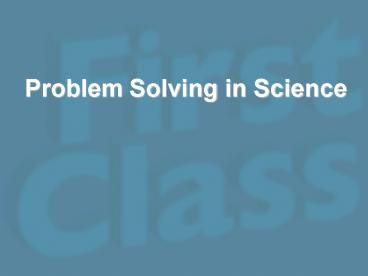Problem Solving in Science - PowerPoint PPT Presentation
1 / 37
Title:
Problem Solving in Science
Description:
County Science Fair. Project Categories. for Grades 4-5. Life Sciences. Physical Sciences ... Science Fair Project. Guide to the Science Fair & Classroom ... – PowerPoint PPT presentation
Number of Views:84
Avg rating:3.0/5.0
Title: Problem Solving in Science
1
Problem Solving in Science
2
County Science FairProject Categoriesfor K - 3
- Collection Display
- Demonstration
- Engineering and Design
- Experimentation
3
County Science FairProject Categoriesfor Grades
4-5
- Life Sciences
- Physical Sciences
- Earth Space Sciences
- Engineering
- Mathematics Computer Science
- Behavioral Social Science
4
All Project Categories
- K - 3
- Collection Display
- Demonstration
- Engineering Design
- Experimentation
- 4-5
- Life Sciences
- Physical Sciences
- Earth Space Sciences
- Engineering
- Mathematics Computer Science
- Behavioral Social Science
5
The project must begin with a well written
problem.
- What makes my car go slower? or Does a vehicle go
slower when it carries more weight? - vs.
- How does the weight of the load affect the speed
of a vehicle?
6
Identifying Variables
- Independent variable
- Dependent variable
- Controlled variables
7
How does the weight of the load affect the speed
of my vehicle?
- This is a well written problem.
8
How does the weight of the load affect the speed
of my vehicle?
- This is the variable you choose to change as you
investigate. - This is called the INDEPENDENT variable.
9
(No Transcript)
10
How does the weight of the load affect the speed
of my vehicle?
- This is the variable you will measure.
- The speed depends on the weight.
- This is the DEPENDENT variable.
11
(No Transcript)
12
How does the weight of the load affect the speed
of my vehicle?
The variable we are changing is the load
(weight). The variable we are measuring is the
speed. All other variables must be kept the same.
These are called CONTROLLED variables.
13
Controlled Variables
- The same vehicle must be used for all tests
- The starting and ending points must all be the
same - The number of washers used to pull the vehicle
must be the same for all trials
14
Hypothesis
- This is a statement of what you predict will
happen. - I think that the heavier the load the slower
the vehicle will move because when I pull things
in my wagon it is harder for me when it is
heavier so I think that will make the vehicle go
slower.
15
A clear process or procedure should be followed.
16
Repeated Trials
- It is important to do each trial of the
investigation at least 3 times. The more trials
that are conducted in an investigation, the more
likely it is that the results will be valid. - If obvious errors occur during a trial, that data
should not be used, and a new trial should be
conducted.
17
Students should be actively involved in
collecting and organizing data.
- Tables
- Charts
- Graphs
18
Analyzing the collected data is very important to
the success of the project. Projects often have a
let-down in this area.
19
Students must make a conclusion based on their
data.
- The heavier the load on the vehicle, the
slower the vehicle traveled the distance marked
on the table. With no extra load, the vehicle
took only 5 seconds. With one block it took an
average of 7 seconds, and with two two blocks it
took an average of 11 seconds.
20
An important step is to share what was learned
and/or to do some research to make a practical
application.
- In this investigation a student might want to
learn how engineers decide how much of a load
trucks carry. - or
- What features do real cars and trucks have that
help them carry heavy loads?
21
Displaying YourScience Fair Project
22
(No Transcript)
23
(No Transcript)
24
(No Transcript)
25
(No Transcript)
26
(No Transcript)
27
(No Transcript)
28
(No Transcript)
29
(No Transcript)
30
(No Transcript)
31
(No Transcript)
32
(No Transcript)
33
(No Transcript)
34
(No Transcript)
35
(No Transcript)
36
Guide to the Science Fair Classroom Problem
Solving
- http//www.fcpsteach.org/docs/SciFair20Handbook.p
df
37
PROBLEM SOLVING
- Does the problem appear on or is it attached to
the project? - Is the problem really a problem or just a
question? - Is a reasonable hypothesis given?
- Is the hypothesis based on prior knowledge or
research as opposed to being a guess? - Is data collected and displayed appropriately?
- Were variables identified and controlled?
- Does the students conclusion follow logically
from the data gathered - or is it incorrectly
based on the students original perception, or
does it not reflect the data that was collected?































